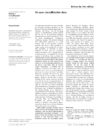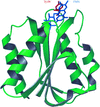issue contents
April 2001 issue

Cover illustration: Dimeric arrangement of human p73![[alpha]](/logos/entities/alpha_rmgif.gif) sterile
sterile ![[alpha]](/logos/entities/alpha_rmgif.gif) -motif related by a crystallographic twofold axis (p. 545). This figure was generated with bobscript [Esnouf, R. M. (1997). J. Mol. Graph. 15, 132-134] and rendered with Raster3D [Meritt, E. A. & Bacon, D. J. (1997). Methods Enzymol. 277, 505-524].
-motif related by a crystallographic twofold axis (p. 545). This figure was generated with bobscript [Esnouf, R. M. (1997). J. Mol. Graph. 15, 132-134] and rendered with Raster3D [Meritt, E. A. & Bacon, D. J. (1997). Methods Enzymol. 277, 505-524].
letters to the editor
Free 

The idea of saving crystallization data of biological macromolecules in a database, as are atomic coordinates, is discussed.
research papers
Structures of a tryptophan-containing variant of the IgG-binding B1 domain of protein L have been solved in the presence and absence of zinc. The binding of zinc ions immobilized the N-terminal histidine tag and enabled the determination of the structural conformation of the histidine tag and its zinc coordination scheme. A methyl-sized cavity was found in these structures, which may explain the greater than expected destabilizing effect of several mutants.
Structural radiation damage has been examined for two high-resolution trypsin structures at 0.95 and 1.00 Å. The high intensity of ID14-EH4 at ESRF is most harmful to cryocooled protein crystals, as disulfide bonds are broken and more alternate conformations are found.
The structure of human pancreatic RNase contributes to the development of new applications in cancer diagnostics.
PDB reference: RNase 1ΔN7, 1e21
X-ray crystal structures of three forms of human mitochondrial branched-chain aminotransferase were solved by molecular-replacement methods. In two of the forms the enzyme is in its active form, with the pyridoxal 5′-phosphate (PLP) cofactor covalently linked to the ∊-amino group of the active-site lysine. In the third form, a molecule of the Tris buffer is covalently bound to the PLP on one end and the active-site lysine on the other, inhibiting the enzyme irreversibly.
The crystal structure of bovine pancreatic phospholipase A2 has been refined to 0.97 Å resolution. The structure presents flexibility at the surface where the key interfacial recognition site is located; a cluster of MPD molecules near the active site was visualized and the modelled solvent region was expanded.
PDB reference: bovine pancreatic phospholipase A2, 1g4i
Two mutants of D. vulgaris flavodoxin, Y98H and Y98W, have been solved to 2.0 and 1.5 Å, respectively. A comparison is made between the two mutants and the different oxidation states of the native flavodoxin.
Here, the identification by X-ray crystallography of a small-molecule binding site on the integrase catalytic domain is reported. The small-molecule family studied consists of a core of arsenic or phosphorus surrounded by four aromatic groups.
The structure of human p73α SAM domain has the five-helix bundle fold that is characteristic of all SAM-domain structures, with an overall r.m.s.d. of 1.5 Å for main-chain atoms compared with the solution structure. Several unusual structural features that might have functional implications are described.
PDB reference: p73α SAM domain, 1dxs
A novel crystal form of T. thermophilus aspartyl-tRNA synthetase (AspRS-1) prepared in the presence of polyethylene glycol and agarose is suitable for structure determination at high resolution.
The SecA translocation ATPase acts as a molecular motor which drives the translocation of proteins through bacterial membranes. In doing so it undergoes large conformational changes and this flexibility may hinder crystallization of the protein. Stabilization of this protein's conformation and its crystallization have been achieved using high glycerol concentrations.
Solvent behaviour in flash-cooled protein crystals was assessed by monitoring the expansion of unit-cell parameters as a function of temperature. Solvent in large channels undergoes a glass transition and crystallizes at 155 K.
A new map-validation procedure based on the correlation-coefficient agreement between the observed structure-factor magnitudes and their extrapolated values from suitably modified electron-density maps from which they have been each in turn systematically excluded is presented.
crystallization papers
Single crystals of C. sinensis 26 kDa glutathione S-transferase and its fusion proteins with peptides of different lengths have been grown in the same crystal form under similar crystallization conditions.
DmpFG-encoded 4-hydroxy-2-ketovalerate aldolase–aldehyde dehydrogenase (acylating) from Pseudomaonas sp. strain CF600 has been crystallized and data collected to 2.1 Å resolution. Three isomorphous heavy-atom derivatives have been identified.
Human ketohexokinase has been produced in E. coli, purified and crystallized in an orthorhombic form (space group P21212 or P212121) with four protein molecules in the asymmetric unit.
Human type 3 3α-hydroxysteroid dehydrogenase has been crystallized in ternary complex with testosterone and NADP+ and diffracts to 1.6 Å.
The human phosphoglucose isomerase (PGI) enzyme has been overproduced in the heterologous E. coli expression system and crystallized, allowing its X-ray structure determination.
Cobra venom factor, a three-chain complement-activating glycoprotein, has been crystallized for the first time. The crystals belong to space group P41 with unit-cell dimensions a = b = 62.7, c = 368.1 Å and diffract to at least 2.7 Å resolution.
A phospholipase A2 from the venom of B. moojeni has been crystallized and data have been collected to 2.35 Å. The structure was solved by molecular-replacement techniques.
This report describes for the first time the preliminary crystallographic and structural studies of EcTI (E. contortisiliquum trypsin inhibitor), a plant Kunitz trypsin inhibitor composed of two polypeptide chains. EcTI has properties such as inhibition of blood clotting and fibrinolytic enzymes (factor XIIa and plasmin) which are not shared by other members of the same family of known structure.
B7-1 is a heavily glycosylated cell-surface molecule and a key target for human immunotherapy. Detailed methods for crystallizing this important but difficult protein are presented.
Preliminary X-ray data of the unbound and mannose-bound forms of MornigaM, a mannose-specific jacalin-related lectin from M. nigra, show the tetrameric assembly of this protein.
Homologues of the E. coli surE protein are well conserved among both the eubacteria and the archaea. The surE protein from T. maritima has been crystallized and diffraction data have been collected to 1.9 Å resolution.
Thermostable alkaline phosphatase from Thermus sp. 3041 has been expressed in E. coli, purified and crystallized. The crystals belong to space group P21221, with unit-cell parameters a = 57.7, b = 69.9, c = 111.5 Å.
The guanylate kinase-like domain of PSD-95 from R. norvegicus has been crystallized in a form suitable for X-ray diffraction studies. The crystals belong to space group P43 (or P41) and diffract to 2.35 Å.


 journal menu
journal menu










































